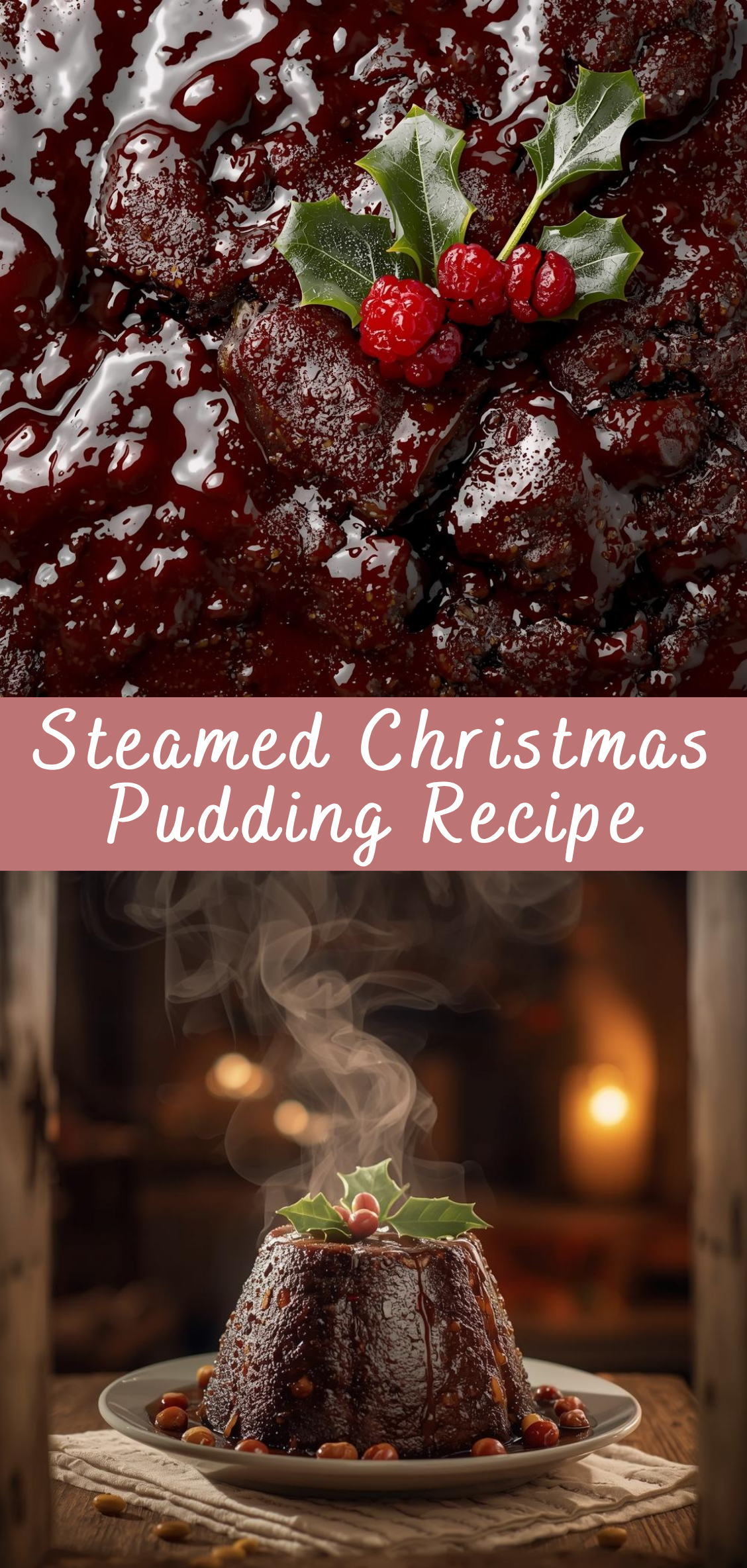Steamed Christmas Pudding
Few desserts evoke the warmth, nostalgia, and festive spirit of the holiday season quite like a classic Christmas pudding. Dense, dark, and richly scented with spices, dried fruits, and a hint of alcohol, this iconic steamed dessert has graced tables for centuries, carrying with it tradition, stories, and the comforting promise of indulgence. A true Christmas pudding is not just a dessert — it is an experience, a celebration of flavors that have been perfected through generations, and a centerpiece that brings together family, friends, and cherished memories.

The origins of Christmas pudding trace back to medieval England, when it began as a pottage of grains, dried fruits, and meat known as “frumenty.” Over time, the dish evolved, absorbing spices and dried fruits from global trade routes, gradually becoming sweeter, richer, and more complex. By the Victorian era, the steamed Christmas pudding we recognize today — dark, moist, and often flambéed with brandy before serving — had firmly cemented itself as the quintessential holiday dessert.
Steaming is the heart of the pudding’s distinctive texture. Unlike baked desserts, which can dry out, steaming ensures a moist, almost velvety consistency, allowing flavors to meld over time. Each spoonful carries the warmth of cinnamon, nutmeg, and cloves, balanced by the deep richness of suet or butter, the sweetness of brown sugar, and the tangy, chewy bite of dried fruits like currants, raisins, and sultanas. The addition of brandy or dark rum not only imbues the pudding with a subtle warmth but also acts as a preservative, allowing the pudding to mature and intensify in flavor for days or even weeks.
The preparation of a Christmas pudding is, in itself, a labor of love. The process begins with careful chopping, soaking, and mixing of fruits and nuts, followed by the meticulous incorporation of fats, eggs, flour, and a symphony of spices. Many families maintain the tradition of “stir-up Sunday,” held weeks before Christmas, where everyone in the household takes a turn stirring the pudding mixture clockwise while making a wish. This ritual is as important as the pudding itself, embedding the dessert with intention, joy, and a sense of connection across generations.
Presentation elevates the pudding from mere dessert to spectacle. Served at the table, a traditional Christmas pudding is often doused in warm brandy and set alight, sending flickers of flame dancing across the dark surface. The sight and scent are instantly festive: the aroma of spiced fruits mingling with caramelized sugar and rich alcohol, the deep brown color inviting eager forks, and the delicate steam rising as slices are served. It is a dessert that demands attention and reverence, a centerpiece that signals celebration.
What makes a Christmas pudding truly special is its complexity — a balance of sweet and spice, richness and acidity, texture and aroma. Dried fruits provide chewiness and natural sweetness, nuts contribute a satisfying crunch, and the careful use of alcohol and spices ensures each bite resonates with depth. The pudding is often served with accompaniments that complement its intensity: a generous pour of brandy butter, a rich custard, or even a dollop of cream. Each addition enhances the layers of flavor, turning every serving into a multisensory experience.
In modern kitchens, the traditional Christmas pudding can be adapted while still honoring its heritage. Variations include incorporating different dried fruits, nuts, and alcohols, or even crafting vegan or gluten-free versions without sacrificing flavor or texture. Yet, no matter the adaptation, the essence remains the same: a rich, spiced, fruit-laden pudding that is steamed to perfection and meant to be shared with loved ones.
The following recipe is designed to guide both experienced bakers and novices through the process of creating a classic steamed Christmas pudding. It emphasizes attention to detail, thoughtful ingredient selection, and proper technique to ensure a moist, flavorful dessert that will delight both the eye and the palate. From soaking the fruits and blending spices to steaming the pudding and preparing it for a dramatic Christmas table presentation, every step will be explained thoroughly, providing tips, variations, and expert insights.
Ultimately, making a Christmas pudding is more than a culinary endeavor — it is a celebration of tradition, patience, and joy. The aroma that fills the kitchen during steaming evokes the spirit of the season; the deep, rich flavors honor centuries of baking wisdom; and the final presentation, whether flambéed or simply served with cream, delivers a moment of festive magic. Steamed Christmas pudding is a testament to the power of dessert to bring people together, bridging generations and creating memories that linger long after the last bite.
Steamed Christmas Pudding: Detailed Instructions
1. Preparing Your Ingredients and Workspace
Preparation is the foundation of a perfect Christmas pudding. This dessert requires careful handling of multiple ingredients, so setting up your workspace in advance will ensure a smooth process.
Equipment needed:
-
Large mixing bowl
-
Medium bowl for soaking fruits
-
Wooden spoon or silicone spatula
-
Measuring cups and spoons
-
Steaming basin or pudding basin (1.2–1.5 liters recommended)
-
Cheesecloth or parchment paper
-
Large saucepan with lid for steaming
-
Kitchen twine
Ingredient preparation tips:
-
Dried fruits: Choose high-quality raisins, sultanas, currants, and mixed peel. Wash and inspect for any debris.
-
Alcohol soak: Use brandy, rum, or sherry to soak fruits, ensuring deep flavor penetration. If avoiding alcohol, strong brewed tea or fruit juice works as a substitute.
-
Spices: Freshly ground spices (cinnamon, nutmeg, cloves, allspice) provide a more vibrant aroma than pre-ground blends.
-
Fat: Traditionally suet is used for a rich texture, but unsalted butter can serve as an alternative. Room temperature butter ensures even incorporation.
-
Nuts: Toasted almonds or walnuts add crunch; chop to uniform size for even distribution.
Tip: Arrange all ingredients near your workstation. This “mise en place” will make mixing smoother and prevent accidental omissions.
2. Soaking the Fruits
The fruit soak is crucial for flavor depth and moisture.
-
In a medium bowl, combine:
-
2 cups raisins
-
1 cup sultanas
-
1 cup currants
-
½ cup chopped mixed peel
-
½ cup chopped dried figs or dates (optional for extra richness)
-
-
Pour over ½–¾ cup brandy, rum, or sherry, ensuring all fruits are submerged.
-
Cover with plastic wrap and let soak at least 12 hours or overnight.
-
The longer the soak, the more plump and flavorful the fruits.
-
Stir occasionally to coat fruits evenly with the alcohol.
-
3. Preparing the Pudding Mixture
-
In a large mixing bowl, combine:
-
1 cup suet or softened butter
-
1 cup dark brown sugar
-
-
Beat until light and creamy, creating a foundation for moisture and richness.
-
Add 3 large eggs, one at a time, beating gently after each addition to ensure full incorporation.
-
Gradually fold in the soaked fruits with their liquid. Stir slowly to avoid crushing the plump fruits, which maintain the pudding’s texture.
-
Add:
-
1 cup all-purpose flour
-
1 teaspoon baking powder
-
½ teaspoon salt
-
-
Incorporate spices:
-
1 teaspoon ground cinnamon
-
½ teaspoon ground nutmeg
-
½ teaspoon ground cloves
-
Optional: ¼ teaspoon ground allspice for depth
-
-
Mix in:
-
½ cup finely chopped toasted almonds or walnuts
-
Zest of one lemon and one orange to brighten the flavor
-
-
Fold the mixture gently, ensuring all ingredients are evenly distributed. The resulting batter should be thick, moist, and aromatic.
4. Preparing the Pudding Basin
-
Grease the pudding basin thoroughly with butter to prevent sticking.
-
Line the base with a round of parchment paper for extra insurance.
-
Spoon the pudding mixture into the basin, pressing gently to remove air pockets. Leave 1–2 inches of space at the top, as the pudding will expand during steaming.
-
Cover the basin with a double layer of parchment paper or cheesecloth. Secure tightly with kitchen twine, making a handle if desired.
-
The cover prevents condensation from dripping onto the pudding and maintains moisture.
-
5. Steaming the Pudding
-
Place the pudding basin in a large saucepan or stockpot.
-
Pour boiling water to reach halfway up the sides of the basin.
-
Cover the saucepan with a tight-fitting lid to trap steam.
-
Steam gently over low heat for 4–6 hours, topping up water as needed to maintain level.
-
The low, slow steam ensures even cooking and a moist texture.
-
Check periodically but avoid lifting the lid too often, as this releases steam.
-
-
Test for doneness: Insert a skewer into the center. It should come out clean or with only moist crumbs.
6. Cooling and Storing
-
Allow the pudding to cool completely in the basin before removing the cover.
-
Wrap the cooled pudding in fresh parchment or foil and store in a cool, dark place.
-
Maturation: For deeper flavor, age the pudding for 2–4 weeks, occasionally adding a splash of alcohol to enhance richness.
7. Reheating Before Serving
-
Place the pudding back in a basin or steamer.
-
Steam gently for 1–2 hours until heated through.
Tip: Steaming rather than microwaving preserves moisture and prevents the pudding from drying out.
8. Serving the Christmas Pudding
-
For a traditional presentation, heat ¼ cup brandy in a small saucepan until warm.
-
Pour over the pudding and ignite carefully for a dramatic flaming effect.
-
Slice and serve with accompaniments:
-
Brandy butter
-
Custard
-
Double cream
-
Visual note: A glossy, dark pudding crowned with flames or powdered sugar embodies the holiday spirit.
9. Chef’s Notes and Tips
-
Ingredient variation: Swap some fruits for cherries, cranberries, or prunes.
-
Alcohol-free version: Replace spirits with fruit juice or strong brewed tea for a child-friendly pudding.
-
Nuts and texture: Chopped nuts can be toasted for enhanced flavor.
-
Make ahead: Pudding improves with time, allowing flavors to meld beautifully.
-
Steaming alternative: If a steamer isn’t available, a deep stockpot with a trivet works perfectly.
10. The Sensory Experience
A perfectly steamed Christmas pudding offers a deep, multi-layered flavor profile: the chew of dried fruits, the warmth of spices, the richness of suet or butter, and the tangy brightness of citrus zest. The aroma fills the home, conjuring images of festive gatherings, cozy kitchens, and generations of tradition. Every slice, every bite, is a celebration of the season and a testament to patience, care, and culinary heritage.
Steamed Christmas Pudding Recipe
Few desserts evoke the warmth, nostalgia, and festive spirit of the holiday season quite like a classic Christmas pudding. Dense, dark, and richly scented with spices, dried fruits, and a hint of alcohol, this iconic steamed dessert has graced tables for centuries, carrying with it tradition, stories, and the comforting promise of indulgence. A true Christmas pudding is not just a dessert — it is an experience, a celebration of flavors that have been perfected through generations, and a centerpiece that brings together family, friends, and cherished memories.
Ingredients
- 1 cup (150 g) raisins
- 1 cup (150 g) sultanas
- ½ cup (75 g) currants
- ½ cup (75 g) chopped dried figs or dates (optional)
- ½ cup (75 g) glace cherries, halved
- ½ cup (120 ml) dark rum, brandy, or stout
- 1 cup (100 g) chopped nuts (walnuts, almonds, or pecans)
- 1 cup (125 g) fresh breadcrumbs
- 1 cup (125 g) all-purpose flour
- ½ tsp salt
- 1 tsp ground cinnamon
- ½ tsp ground nutmeg
- ½ tsp ground allspice
- ½ tsp ground cloves
- 1 cup (200 g) brown sugar
- 1 cup (225 g) unsalted butter, softened
- 4 large eggs, beaten
- Zest of 1 lemon
- Zest of 1 orange
- ½ cup (120 ml) milk
- Optional: extra rum or brandy for flaming and serving
Instructions
1. Prepare the Fruit
- Place raisins, sultanas, currants, figs, and cherries in a bowl.
- Pour over rum, brandy, or stout. Stir and cover. Leave to soak overnight (or at least a few hours).
2. Mix the Pudding Batter
- In a large mixing bowl, cream together butter and brown sugar until light and fluffy.
- Beat in eggs one at a time.
- Add lemon and orange zest, soaked fruits (with any remaining liquid), and nuts.
- In a separate bowl, whisk together flour, breadcrumbs, salt, and spices.
- Gradually fold dry ingredients into wet mixture.
- Stir in milk until combined.
3. Prepare the Pudding Basin
- Grease a 2-liter (8-cup) pudding basin.
- Spoon batter into basin and smooth the top.
- Cover with a double layer of greased parchment paper and a layer of aluminum foil, pleated in the center to allow expansion. Secure with string.
4. Steam the Pudding
- Place the basin in a large pot.
- Pour in boiling water to come halfway up the sides of the basin.
- Cover the pot with a lid and steam for 6 hours, checking water level periodically and topping up with boiling water as needed.
5. Cool and Store
- Allow pudding to cool completely.
- Store in a cool, dark place. Can be made several weeks in advance (pudding matures and flavor improves). Reheat by steaming for 2 hours before serving.
6. Serve
- Turn pudding out onto a serving plate.
- Optional: Warm 2–3 tbsp of brandy, pour over pudding, and flambé just before serving.
- Serve with brandy butter, cream, or custard.
Notes
- Steaming Tip: Keep water boiling gently to avoid burning the pudding or cracking the basin.



